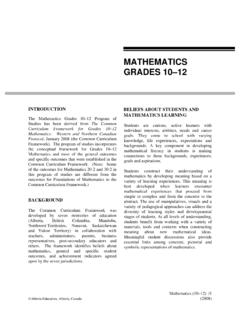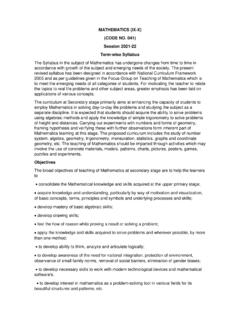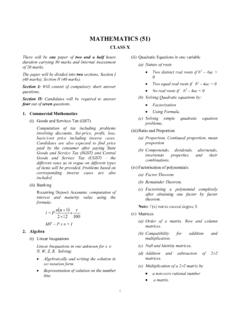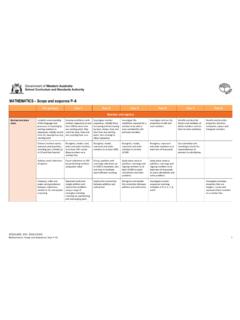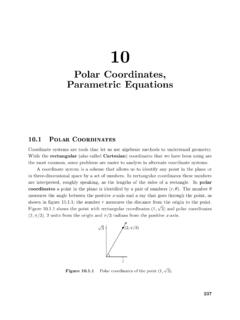Transcription of 2.10. Sympy : Symbolic Mathematics in Python
1 Sympy : Symbolic Mathematics in Pythonauthor:Fabian PedregosaObjectives1. Evaluate expressions with arbitrary Perform algebraic manipulations on Symbolic Perform basic calculus tasks (limits, differentiation andintegration) with Symbolic Solve polynomial and transcendental Solve some differential is Sympy ? Sympy is a Python library for Symbolic Mathematics . It aims become a full featuredcomputer algebra system that can compete directly with commercial alternatives (Mathematica, Maple)while keeping the code as simple as possible in order to be comprehensible and easily extensible. SymPyis written entirely in Python and does not require any external documentation and packages for installation can be found on contentsFirst Steps with SymPyUsing Sympy as a calculatorExercisesSymbolsAlgebraic manipulationsExpandSimplifyExercisesCalc ulusLimitsDifferentiationSeries expansionExercisesIntegrationExercisesEq uation solvingExercisesLinear AlgebraMatricesDifferential First Steps with Using Sympy as a calculatorSymPy defines three numerical types: Real, Rational and Rational class represents a rational number as a pair of two Integers: the numerator and the denomi nator, so Rational(1,2) represents 1/2, Rational(5,2) 5/2 and so on: Sympy uses mpmath in the background, which makes it possible to perform computations using arbitrary-precision arithmetic.
2 That way, some special constants, like e, pi, oo (Infinity), are treated as symbols andcan be evaluated with arbitrary precision:as you see, evalf evaluates the expression to a floating-point is also a class representing mathematical infinity, called oo:>>> from Sympy import *>>> a = Rational(1,2)>>> a1/2>>> a*21>>>>>>>>> pi**2pi**2>>> () >>> (pi+exp(1)).evalf() >>>>>>>>> oo > 99999 True>>> oo + 1oo>>>>>> Exercises1. Calculate with 100 Calculate in rational SymbolsIn contrast to other Computer Algebra Systems, in Sympy you have to declare Symbolic variablesexplicitly:Then you can manipulate them:Symbols can now be manipulated using some of Python operators: +, -, *, ** (arithmetic), &, |, ~ , >>, <<(boolean). Algebraic manipulationsSymPy is capable of performing powerful algebraic manipulations. We ll take a look into some of the mostfrequently used: expand and ExpandUse this to expand an algebraic expression.
3 It will try to denest powers and multiplications:In [23]: expand((x+y)**3)Out[23]: 3*x*y**2 + 3*y*x**2 + x**3 + y**3 Further options can be given in form on keywords:In [28]: expand(x+y, complex=True)>>> from Sympy import *>>> x = Symbol('x')>>> y = Symbol('y')>>>>>>>>> x+y+x-y2*x>>> (x+y)**2(x + y)**2>>>>>>Out[28]: I*im(x) + I*im(y) + re(x) + re(y)In [30]: expand(cos(x+y), trig=True)Out[30]: cos(x)*cos(y) - sin(x)*sin(y) SimplifyUse simplify if you would like to transform an expression into a simpler form:In [19]: simplify((x+x*y)/x)Out[19]: 1 + ySimplification is a somewhat vague term, and more precises alternatives to simplify exists: powsimp (sim plification of exponents), trigsimp (for trigonometric expressions) , logcombine, radsimp, Exercises1. Calculate the expanded form of .2. Simplify the trigonometric expression sin(x) / cos(x) LimitsLimits are easy to use in Sympy , they follow the syntax limit(function, variable, point), so to compute thelimit of f(x) as x -> 0, you would issue limit(f, x, 0):you can also calculate the limit at infinity:>>> limit(sin(x)/x, x, 0)1>>>>>>>>> limit(x, x, oo)oo>>> limit(1/x, x, oo)0>>> limit(x**x, x, 0)>>>>>> DifferentiationYou can differentiate any Sympy expression using diff(func, var).
4 Examples:You can check, that it is correct by:Higher derivatives can be calculated using the diff(func, var, n) Series expansionSymPy also knows how to compute the Taylor series of an expression at a point. Use series(expr, var) Exercises1. Calculate 2. Calulate the derivative of log(x) for >>> diff(sin(x), x)cos(x)>>> diff(sin(2*x), x)2*cos(2*x)>>> diff(tan(x), x)1 + tan(x)**2>>>>>>>>> limit((tan(x+y)-tan(x))/y, y, 0)1 + tan(x)**2>>>>>>>>> diff(sin(2*x), x, 1)2*cos(2*x)>>> diff(sin(2*x), x, 2)-4*sin(2*x)>>> diff(sin(2*x), x, 3)-8*cos(2*x)>>>>>>>>> series(cos(x), x)1 - x**2/2 + x**4/24 + O(x**6)>>> series(1/cos(x), x)1 + x**2/2 + 5*x**4/24 + O(x**6)>>>>>> IntegrationSymPy has support for indefinite and definite integration of transcendental elementary and special func tions via integrate() facility, which uses powerful extended Risch-Norman algorithm and some heuristicsand pattern matching. You can integrate elementary functions:Also special functions are handled easily:It is possible to compute definite integral:Also improper integrals are supported as Equation solvingSymPy is able to solve algebraic equations, in one and several variables:In [7]: solve(x**4 - 1, x)Out[7]: [I, 1, -1, -I]>>> integrate(6*x**5, x)x**6>>> integrate(sin(x), x)-cos(x)>>> integrate(log(x), x)-x + x*log(x)>>> integrate(2*x + sinh(x), x)cosh(x) + x**2>>>>>>>>> integrate(exp(-x**2)*erf(x), x)pi**(1/2)*erf(x)**2/4>>>>>>>>> integrate(x**3, (x, -1, 1))0>>> integrate(sin(x), (x, 0, pi/2))1>>> integrate(cos(x), (x, -pi/2, pi/2))2>>>>>>>>> integrate(exp(-x), (x, 0, oo))1>>> integrate(exp(-x**2), (x, -oo, oo))pi**(1/2)>>>>>>As you can see it takes as first argument an expression that is supposed to be equaled to 0.
5 It is able tosolve a large part of polynomial equations, and is also capable of solving multiple equations with respectto multiple variables giving a tuple as second argument:In [8]: solve([x + 5*y - 2, -3*x + 6*y - 15], [x, y])Out[8]: {y: 1, x: -3}It also has (limited) support for trascendental equations:In [9]: solve(exp(x) + 1, x)Out[9]: [pi*I]Another alternative in the case of polynomial equations is factor. factor returns the polynomial factorizedinto irreducible terms, and is capable of computing the factorization over various domains:In [10]: f = x**4 - 3*x**2 + 1In [11]: factor(f)Out[11]: (1 + x - x**2)*(1 - x - x**2)In [12]: factor(f, modulus=5)Out[12]: (2 + x)**2*(2 - x)**2 Sympy is also able to solve boolean equations, that is, to decide if a certain boolean expression is satisfi able or not. For this, we use the function satisfiable:In [13]: satisfiable(x & y)Out[13]: {x: True, y: True}This tells us that (x & y) is True whenever x and y are both True.
6 If an expression cannot be true, novalues of its arguments can make the expression True, it will return False:In [14]: satisfiable(x & ~x)Out[14]: Exercises1. Solve the system of equations , 2. Are there boolean values x, y that make (~x | y) & (~y | x) true? Linear MatricesMatrices are created as instances from the Matrix class:unlike a NumPy array, you can also put Symbols in Differential EquationsSymPy is capable of solving (some) Ordinary Differential Equations. works like this:In [4]: f(x).diff(x, x) + f(x)Out[4]: 2 d!!!!!(f(x)) + f(x)dx dxIn [5]: dsolve(f(x).diff(x, x) + f(x), f(x))Out[5]: C *sin(x) + C *cos(x)Keyword arguments can be given to this function in order to help if find the best possible resolution sys tem. For example, if you know that it is a separable equations, you can use keyword hint= separable toforce dsolve to resolve it as a separable [6]: dsolve(sin(x)*cos(f(x)) + cos(x)*sin(f(x))*f(x).)
7 Diff(x), f(x), hint= separable ) Out[6]: -log(1- sin(f(x))**2)/2 == C1 + log(1 - sin(x)**2) Exercises1. Solve the Bernoulli differential equation x*f(x).diff(x) + f(x) - f(x)**2! TODO: correct this equation and convert to math directive!>>> from Sympy import Matrix>>> Matrix([[1,0], [0,1]])[1, 0][0, 1]>>>>>>>>> x = Symbol('x')>>> y = Symbol('y')>>> A = Matrix([[1,x], [y,1]])>>> A[1, x][y, 1]>>> A**2[1 + x*y, 2*x][ 2*y, 1 + x*y]>>>>>>2. Solve the same equation using hint= Bernoulli . What do you observe ?







